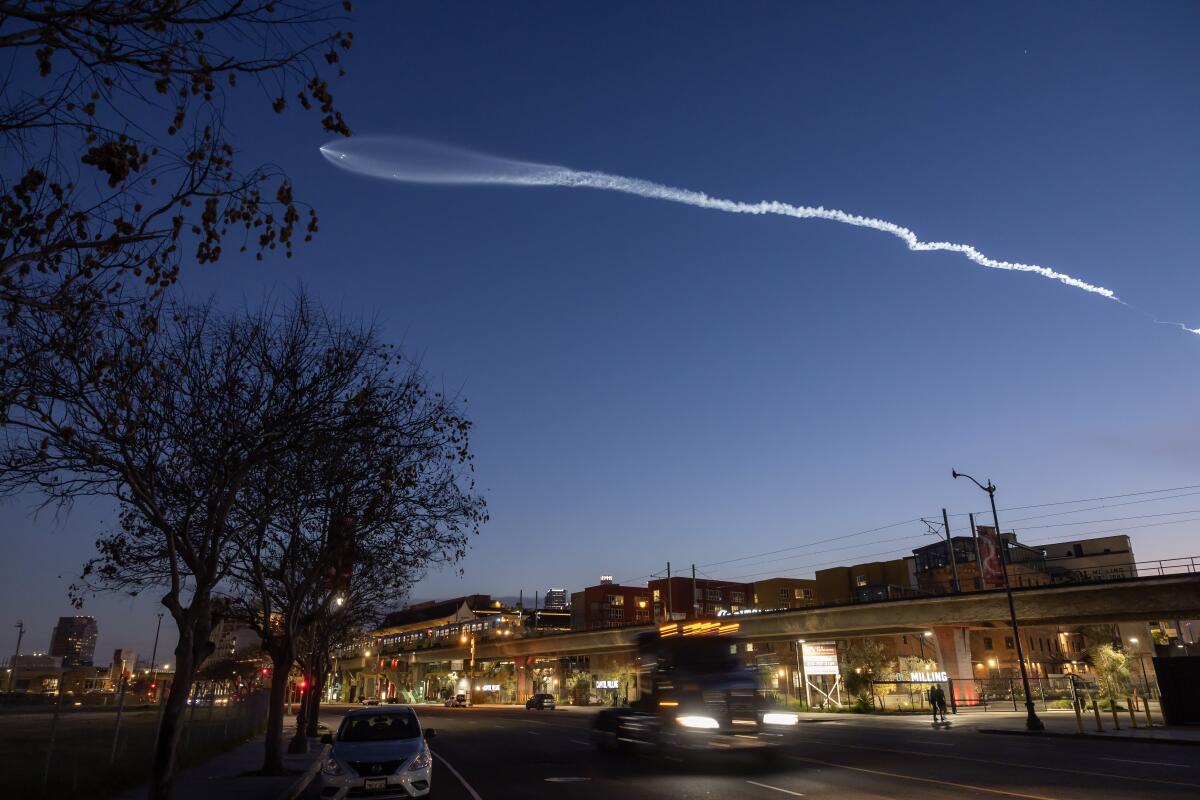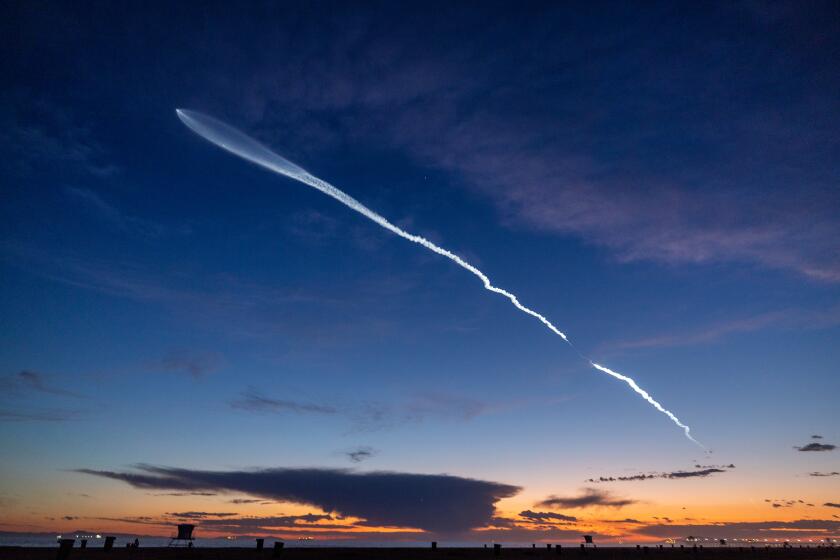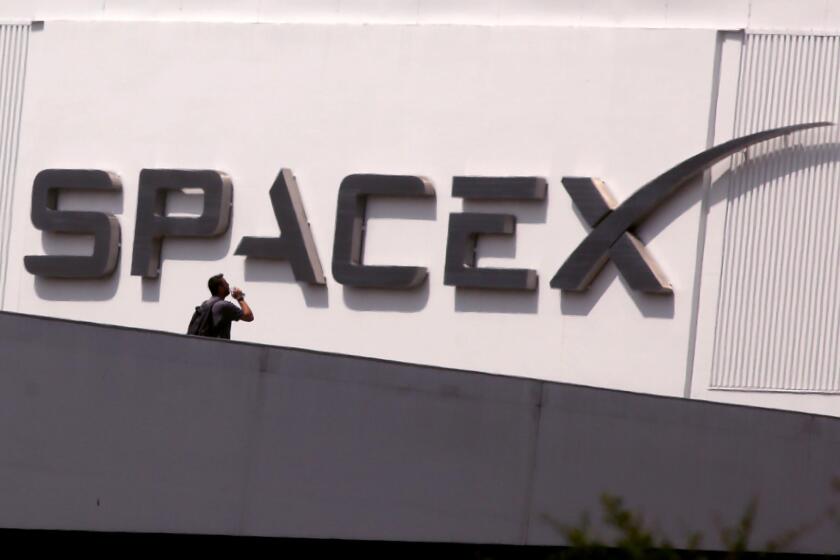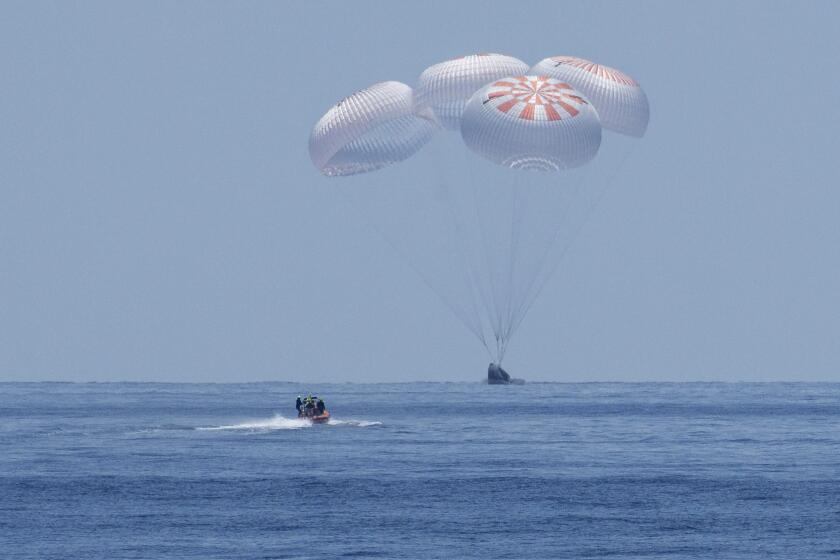U.S. military rejects calls to reduce sonic booms from SpaceX rockets blasting along California coast

- Share via
Military officials are rejecting demands from a state agency to better monitor and mitigate the effects of rocket launches and sonic booms from Vandenberg Space Force Base, frustrating local officials and increasing tensions between the U.S. Space Force and the state agency tasked with preserving the California coast.
SpaceX, a leading contractor with Space Force, wants to rapidly multiply the number of rockets launched from the military base in Santa Barbara County. The company hasn’t been seeking the commission’s approval, however; instead, Space Force officials have been negotiating with the California Coastal Commission for months over a plan to allow 36 launches at the base this year — six times more than the previous agreement allowed.
As part of those talks, the state commission asked Space Force to track and document more closely how the blasts affect wildlife and to consider ways to reduce the harm from sonic booms. The commission can’t impose its will on the military — it can only ask for Space Force to cooperate.
At the commission’s meeting Thursday, what is usually a mild-mannered monthly session turned tense after military officials rejected the additional monitoring and mitigation, and Space Force officials refused to take questions.
Commission members were visibly irked.
“I’m beyond pissed,” said Commissioner Susan Lowenberg. “I don’t understand why our own government is thumbing their nose at another branch of our government.”
Said Commissioner Kristina Kunkel, “I hope this commission won’t be bullied into ignoring environmental protections.”
Space Force officials have admitted that sonic booms from Vandenberg affect over 100 miles of California coast, just as SpaceX aims to ramp up launches.
The discordant meeting came two months after Space Force officials admitted for the first time that sonic booms from rocket launches at the base were regularly rattling residents and wildlife along roughly 100 miles of coast across Santa Barbara, Ventura and Los Angeles counties. Recent changes in rocket trajectories have made the sonic booms more common for residents inland, and Space Force officials have said they’re looking to significantly increase the number of rocket blasts each year.
That steep increase is being fueled mainly by Elon Musk’s SpaceX. The company is currently headquartered in Hawthorne but, according to Musk, those offices are bound for Texas.
A spokesperson for Vandenberg Space Force Base told The Times that the headquarters shift has no effect on the number of rocket launches SpaceX plans to do from the California base. By 2026, SpaceX still plans to launch more than 90 rockets there.
On Thursday, the state commission approved the increase in launches with new requirements for Space Force to increase monitoring of wildlife inside and outside the base and to analyze the effects that sonic booms have on wildlife, such as southern sea otters, California red-legged frogs, western snowy plover and California least tern.
The seven conditions the commission sought to impose included requiring a written plan to minimize the impact and reach of sonic booms, a light management plan for night launches that would limit the reach of lights facing beach areas, and steps to provide more information about the launches and their effects to beach visitors and the fishing industry.
Space Force is already responsible for monitoring the effects of launches on base land, but commission officials insist the significantly higher number of rocket launches and the effects of sonic booms that reach across more than 100 miles of California coast are a significant change from the base’s previous activities and demand broader protections.
Elon Musk’s SpaceX plans to launch 90 rockets into space by 2026, but the California Coastal Commission is raising concerns about how marine life would be affected.
Several of the commissioners said their intent was not to deter rockets from being launched, but to track the effects they could have on the coast.
“We don’t want to stop the rockets, we don’t want to stop their satellites, and we certainly don’t want to enable any kind of defense problem,” said Commissioner Dayna Bochco, visibly upset. “But this is ridiculous.”
On Thursday, Vandenberg officials said they already take steps to safeguard the coast.
“Our goal is to strike a balance between our mission requirements and state regulators,” said Col. Dorian C. Hatcher, vice commander for operations at the base. “We’re safeguarding the environment at Vandenberg. We do so and continually do so because we’re committed stewards, responsible members of the community and recognize it’s not only our responsibility, but duty.”
As they had at previous meetings, though, Space Force officials rejected the demands for additional monitoring and mitigation. That rejection, along with their refusal to answer questions Thursday, seemed to place the state agency in a collision course with the Defense Department.
“Space Force came here and intentionally disrespected us,” Bochco said. “That’s OK. Sometimes I disrespect you, too.”
But what that will mean going forward, and whether base officials intend to comply with the monitoring despite their previous objections, is still unclear. Space Force has the authority to move forward with the rocket launches without reaching an agreement with the coastal commission.
As part of its duty to protect the state’s coastal resources, the commission issues or denies permits for development. But the commission can’t deny a plan by the Defense Department or other federal agency to use federal property near the coast. Instead, the commission is tasked to reach an agreement with the feds to mitigate issues like access to beaches and potential harm to marine life.
Elon Musk’s announcement that he’s moving SpaceX headquarters to Texas could present a blow to Hawthorne and the Southern California space economy that it helped to revive.
According to a report by commission staff, the Air Force’s position is that base officials already monitor wildlife and environmental effects in accordance with U.S. Fish and Wildlife and Marine Mammal Protection requirements. But citing equipment failures and other errors, the commission staff argued that previous monitoring efforts by Space Force have resulted in significant gaps of data, and the force’s reports lack analysis on the launches’ effects on wildlife inside and outside the base.
Staff have also pointed to the military’s recent admission that sonic booms from the rocket launches are more frequent and affect a much wider area of the coast than previously acknowledged.
Cassidy Teuffel, deputy director of the commission, said Thursday that staff at Vandenberg have pushed back at efforts to increase wildlife monitoring, mainly over concerns about the cost.
“What’s more expensive than destroying the environment and then trying to fix it?” Bochco said, before shutting off the audio to her microphone Thursday. “I’m disgusted.”
The relationship between Space Force and the state commission appeared to have been already strained when Space Force officials first approached the commission in May 2023 about increasing the number of rocket launches to 36 from the previously agreed limit of six.
Long before the request was submitted, SpaceX had already exceeded the number of rocket launches allowed. In 2022, the company had done 13 launches from Vandenberg.
Commission staff are also looking at the possibility of requiring SpaceX to seek permits for its commercial, non-military launches at Vandenberg, instead of Space Force seeking an agreement for all launches on the grounds that the company is a government contractor.
SpaceX’s Dragon spacecraft will take a new route home next year after the company announced it will move its splashdowns to the waters off California.
According to commission staff, only about 13% to 20% of SpaceX launches have involved Department of Defense activity. The vast majority has instead been for commercial purposes, mainly for Musk’s Starlink satellite-based broadband provider.
Vandenberg officials have argued all SpaceX launches benefit the Department Defense, not just because the Department of Defense uses Starlink systems, but because SpaceX’s ability to quickly launch more rockets into space benefits the Department of Defense’s goals.
During previous commission hearings, Space Force officials also brushed off questions about sonic booms, telling commissioners that their models had sonic booms occurring mostly over the Channel Islands. It was during the commission hearings that residents began to report they were experiencing sonic booms as far away as Los Angeles County.
Base officials later said recent changes to rocket trajectories had shifted some sonic booms over the mainland, making it possible to hear and feel them across about 100 miles of coast.
Bochco said Space Force had been “misleading” about the sonic booms and was unwilling to work with the state agency.
“They don’t want to monitor, they don’t want to find out the impacts, I assume because they’re not going to do it,” she said.
More to Read
Sign up for Essential California
The most important California stories and recommendations in your inbox every morning.
You may occasionally receive promotional content from the Los Angeles Times.















